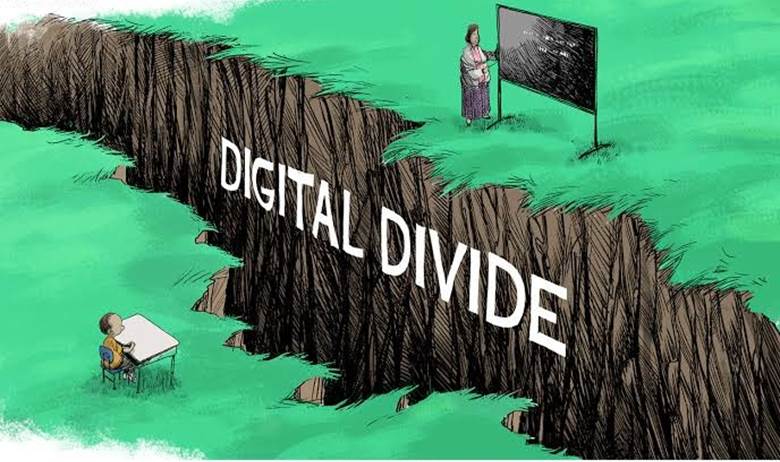Description

Copyright infringement not intended
In News
- The recently released 'India Inequality Report 2022: Digital Divide' by Oxfam India shows the digital divide in India.
- Oxfam said the report depended on primary data received from the Centre for Monitoring Indian Economy's (CMIE) household survey from January 2018 to December 2021 on internet access, mobile ownership, computer and broadband availability as well as report analysis from the National Sample Survey (NSS) data.
Key Points of the report
- Gender inequality
- In India, Over 61% of men owned a mobile phone in 2021 as opposed to 31 % of women.
- Women are 15% less likely to own a mobile phone and 33% less likely to use mobile internet services than men.
- Caste inequality
- 8% of people under the 'General' caste category had access to a computer or a laptop compared to 1% of Scheduled Tribes (ST) or 2% of Scheduled Castes (SC).
- The chances of access to a computer are more for the General and OBC groups than for the SC and ST populations.
- Religion inequality
- Among all religions, Sikhs have the highest chances of having a computer followed by Christians, Hindus and lastly Muslims.
- Among Sikhs, 12% have a computer by the end of 2021, as compared to 2% of Muslims.
- Rural-Urban divide
- The urban population is 7% to 8% more likely to have a computer than the rural population.
- The total percentage of respondents without a computer or laptop was 93.5% in January-April 2018, which further increased to 96.6 % by the end of 2021, indicating the widening of the gap after the Covid-19 pandemic.
- Only one-fifth of the population could operate a computer.
- Maharashtra has the highest internet penetration, followed by Goa and Kerala, while Bihar has the lowest, followed by Chhattisgarh and Jharkhand.
Digital Divide
- It refers to the separation that exists between individuals, communities, and businesses that have access to information technology and those that do not have such access.
- Reason:
- Economic poverty is closely related to limited information technology resources.
- Lack of awareness among the people.
- Concern:
- Awareness cannot guarantee sustained use of the system unless the system is also designed in such a way as to deliver a satisfactory outcome.
- Online safety: The majority of women have experienced online violence, including sexual harassment, threatening messages and having private images shared without consent.
.jpg)
Steps taken by Government to bridge Digital Divide
- National E-governance Plan formulated by the Department of Electronics and Information Technology (DEITY) and the Department of Administrative Reforms and Public Grievances (DARPG) in 2006.
- It aims at improving the delivery of Government services to citizens and businesses with the vision “Make all Government services accessible to the common man in his locality, through common service delivery outlets and ensure efficiency, transparency & reliability of such services at affordable costs to realise the basic needs of the common man.”
- E-District Projects under National e-Governance Plan (NeGP) aims at providing support to the basic administrative unit.
- Common Services Centres provide high-quality and cost-effective video, voice and data content and services, in the areas of e-governance, education, health, telemedicine, entertainment as well as other private services.
- It will offer web-enabled e-governance services in rural areas, including application forms, certificates, and utility payments such as electricity, telephone and water bills.
- Bhoomi Project in Karnataka for Online delivery of Land Records.
- Gyandoot is an Intranet-based Government to Citizen (G2C) service delivery initiative in Madhya Pradesh.
- Lokvani Project in Uttar Pradesh to provide a single window, self-sustainable e-Governance solution for the handling of grievances, land record maintenance and providing a mixture of essential services.
- Project FRIENDS in Kerala: FRIENDS (Fast, Reliable, Instant, Efficient Network for the Disbursement of Services) is a Single Window Facility providing citizens with the means to pay taxes and other financial dues to the State Government
- e-Mitra Project in Rajasthan to facilitate urban and rural masses with the maximum possible services related to different state government departments
- e-Seva (Andhra Pradesh); all the services are delivered online to consumers /citizens by connecting them to the respective government departments and providing online information at the point of service delivery.
- SWAYAM Portal for Online Courses. SWAYAM Prabha Provide HD educational Channels through DTH on a 24X7 basis.
- Bharat Net program to provide high-speed broadband to all the villages, optical fibre has been laid in 1.83 lakh gram panchayats.
Way Forward
- Need to promote Digital literacy, digital skills democracy, social mobility, economic equality and economic growth.
- Procedures need to be simplified to deliver concrete benefits and clear guidelines provided to encourage their users and reduce users’ dependence on middlemen/intermediaries.
- A large investment needs to be made in digital infrastructure, and also needs to strengthen online security or cybersecurity.
- Ensuring equitable access to the digital world would promote economic growth for all. It would Speed up governmental Processes, and also increase transparency and enforce accountability.
.jpg)
https://www.deccanherald.com/assembly-election-2019/report-red-flags-digital-gap-based-on-gender-caste-1168690.html#:~:text=The%20report%2C%20'India%20Inequality%20Report,of%20Scheduled%20Castes%20(SC).
https://t.me/+hJqMV1O0se03Njk9






.jpg)








